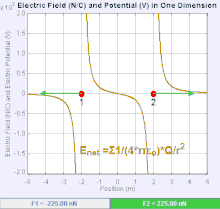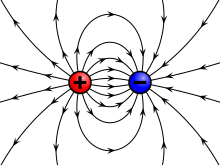
An electric field surrounds electrically charged particles and time-varying magnetic fields. The electric field depicts the surrounding force of an electrically charged particle exerted on other electrically charged objects. The concept of an electric field was introduced by Micha
el Faraday.
Qualitative description
The electric field is a vector field with SI units of newtons per coulomb (N C−1) or, equivalently, volts per metre (V m−1). The SI base units of the electric field are kg⋅m⋅s−3⋅A−1. The strength or magnitude of the field at a given point is defined as the force that would be exerted on a positive test charge of 1 coulomb placed at that point; the direction of the field is given by the direction of that force. Electric fields contain electrical energy with energy density proportional to the square of the field amplitude. The electric field is to charge as gravitational acceleration is to mass and force density is to volume.An electric field that changes with time, such as due to the motion of charged particles in the field, influences the local magnetic field. That is, the electric and magnetic fields are not completely separate phenomena; what one observer perceives as an electric field, another observer in a different frame of reference perceives as a mixture of electric and magnetic fields. For this reason, one speaks of "electromagnetism" or "electromagnetic fields". In quantum electrodynamics, disturbances in the electromagnetic fields are called photons, and the energy of photons is quantized.
Quantitative definition
Consider a point charge q with position (x,y,z). Now suppose the charge is subject to a force Fon q due to other charges. Since this force varies with the position of the charge and by Coloumb's Law it is defined at all points in space, Fon q is a continuous function of the charge's position (x,y,z). This suggests that there is some property of the space that causes the force which is exerted on the charge q. This property is called the electric field and it is defined byFrom the definition, the direction of the electric field is the same as the direction of the force it would exert on a positively charged particle, and opposite the direction of the force on a negatively charged particle. Since like charges repel and opposites attract, the electric field is directed away from positive charges and towards negative charges.
Superposition
Array of discrete point charges
Electric fields satisfy the superposition principle. If more than one charge is present, the total electric field at any point is equal to the vector sum of the separate electric fields that each point charge would create in the absence of the others. the corresponding unit vector.
the corresponding unit vector.Continuum of charges
The superposition principle holds for an infinite number of infinitesimally small elements of charges – i.e. a continuous distribution of charge. The limit of the above sum is the integral:Coulomb's law is actually a special case of Gauss's Law, a more fundamental description of the relationship between the distribution of electric charge in space and the resulting electric field. While Columb's law (as given above) is only true for stationary point charges, Gauss's law is true for all charges either in static or in motion. Gauss's law is one of Maxwell's equations governing electromagnetism.
Gauss's law allows the E-field to be calculated in terms of a continuous distribution of charge density
Electrostatic fields
Main article: Electrostatics
Electrostatic fields are E-fields which do not change with time, which happens when the charges are stationary.Uniform fields
A uniform field is one in which the electric field is constant at every point. It can be approximated by placing two conducting plates parallel to each other and maintaining a voltage (potential difference) between them; it is only an approximation because of edge effects. Ignoring such effects, the equation for the magnitude of the electric field E is:Parallels between electrostatic and gravitational fields
Coulomb's law, which describes the interaction of electric charges: .
.
Similarities between electrostatic and gravitational forces:
- Both act in a vacuum.
- Both are central and conservative.
- Both obey an inverse-square law (both are inversely proportional to square of r).
- Electrostatic forces are much greater than gravitational forces for natural values of charge and mass. For instance, the ratio of the electrostatic force to the gravitational force between two electrons is about 1042.
- Gravitational forces are attractive for like charges, whereas electrostatic forces are repulsive for like charges.
- There are not negative gravitational charges (no negative mass) while there are both positive and negative electric charges. This difference, combined with the previous two, implies that gravitational forces are always attractive, while electrostatic forces may be either attractive or repulsive.
Electrodynamic fields
Main article: Electrodynamics
Electrodynamic fields are E-fields which do change with time, when charges are in motion.An electric field can be produced, not only by a static charge, but also by a changing magnetic field. The electric field is given by:
Energy in the electric field
Main article: Electric potential energy
The electrostatic field stores energy. The energy density u (energy per unit volume) is given by[2]The total energy U stored in the electric field in a given volume V is therefore
Further extensions
Definitive equation of vector fields
In the presence of matter, it is helpful in electromagnetism to extend the notion of the electric field into three vector fields, rather than just one:[3]Constitutive relation
Main article: Constitutive equation
The E and D fields are related by the permittivity of the material, ε.[4][5]For linear, homogeneous, isotropic materials E and D are proportional and constant throughout the region, there is no position dependence: For inhomogeneous materials, there is a position dependence throughout the material:
http://en.wikipedia.org/wiki/Electric_field























No comments:
Post a Comment